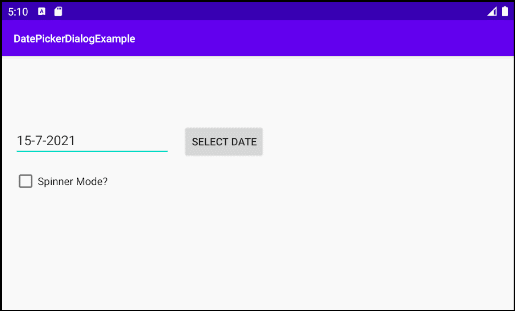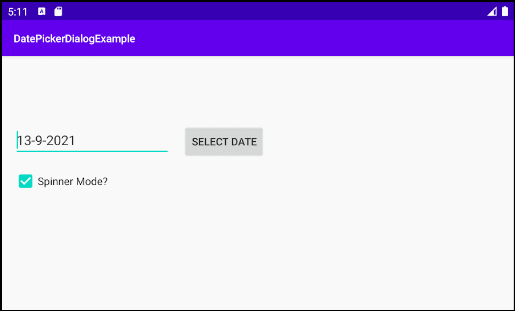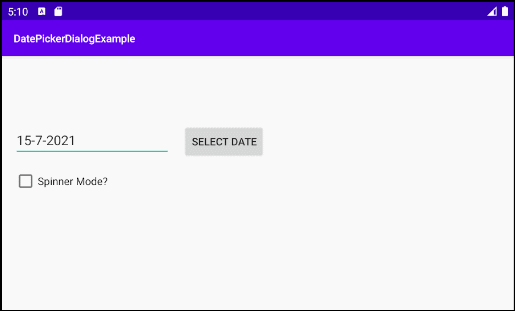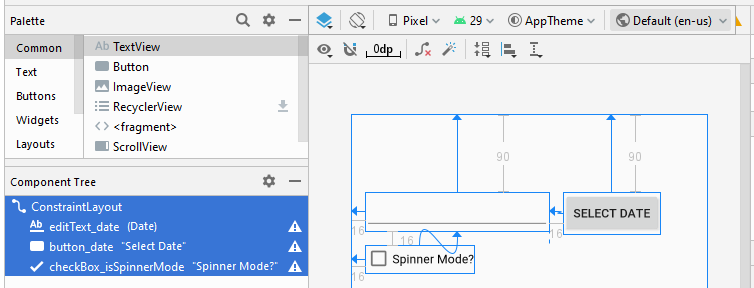Android DatePickerDialog Tutorial with Examples
1. Android DatePickerDialog
Android DatePickerDialog puts a DatePicker on a Dialog. It allows the user to choose a Date. Basically, there is no significant difference between DatePickerDialog and DatePicker, but if you want to save application space, I will recommend you to choose DatePickerDialog.
DatePickerDialog is created at the application runtime when the user needs to select a Date. You can create and get it displayed by using the Java code:
DatePickerDialog (Calendar Mode) (Default)
int selectedYear = 2000;
int selectedMonth = 5;
int selectedDayOfMonth = 10;
// Date Select Listener.
DatePickerDialog.OnDateSetListener dateSetListener = new DatePickerDialog.OnDateSetListener() {
@Override
public void onDateSet(DatePicker view, int year,
int monthOfYear, int dayOfMonth) {
editTextDate.setText(dayOfMonth + "-" + (monthOfYear + 1) + "-" + year);
}
};
// Create DatePickerDialog (Spinner Mode):
DatePickerDialog datePickerDialog = new DatePickerDialog(this,
dateSetListener, selectedYear, selectedMonth, selectedDayOfMonth);
// Show
datePickerDialog.show();
DatePickerDialog (Spinner Mode)
int selectedYear = 2000;
int selectedMonth = 5;
int selectedDayOfMonth = 10;
// Date Select Listener.
DatePickerDialog.OnDateSetListener dateSetListener = new DatePickerDialog.OnDateSetListener() {
@Override
public void onDateSet(DatePicker view, int year,
int monthOfYear, int dayOfMonth) {
editTextDate.setText(dayOfMonth + "-" + (monthOfYear + 1) + "-" + year);
}
};
// Create DatePickerDialog (Spinner Mode):
DatePickerDialog datePickerDialog = new DatePickerDialog(this,
android.R.style.Theme_Holo_Light_Dialog_NoActionBar,
dateSetListener, selectedYear, selectedMonth, selectedDayOfMonth);
// Show
datePickerDialog.show();
2. Example of DatePickerDialog
Example preview:

Calendar Mode

Spinner Mode
Now, create a new project on Android Studio:
- File > New > New Project > Empty Activity
- Name: DatePickerDialogExample
- Package name: org.o7planning.datepickerdialogexample
- Language: Java
The interface of the application will look like this:

activity_main.xml
<?xml version="1.0" encoding="utf-8"?>
<androidx.constraintlayout.widget.ConstraintLayout
xmlns:android="http://schemas.android.com/apk/res/android"
xmlns:app="http://schemas.android.com/apk/res-auto"
xmlns:tools="http://schemas.android.com/tools"
android:layout_width="match_parent"
android:layout_height="match_parent"
tools:context=".MainActivity">
<EditText
android:id="@+id/editText_date"
android:layout_width="wrap_content"
android:layout_height="wrap_content"
android:layout_marginStart="16dp"
android:layout_marginLeft="16dp"
android:layout_marginTop="90dp"
android:ems="10"
android:inputType="date"
app:layout_constraintStart_toStartOf="parent"
app:layout_constraintTop_toTopOf="parent" />
<Button
android:id="@+id/button_date"
android:layout_width="wrap_content"
android:layout_height="wrap_content"
android:layout_marginStart="16dp"
android:layout_marginLeft="16dp"
android:layout_marginTop="90dp"
android:text="Select Date"
app:layout_constraintStart_toEndOf="@+id/editText_date"
app:layout_constraintTop_toTopOf="parent" />
<CheckBox
android:id="@+id/checkBox_isSpinnerMode"
android:layout_width="wrap_content"
android:layout_height="wrap_content"
android:layout_marginStart="16dp"
android:layout_marginLeft="16dp"
android:layout_marginTop="16dp"
android:text="Spinner Mode?"
app:layout_constraintStart_toStartOf="parent"
app:layout_constraintTop_toBottomOf="@+id/editText_date" />
</androidx.constraintlayout.widget.ConstraintLayout>MainActivity.java
package org.o7planning.datepickerdialogexample;
import androidx.appcompat.app.AppCompatActivity;
import android.app.DatePickerDialog;
import android.os.Bundle;
import android.view.View;
import android.widget.Button;
import android.widget.CheckBox;
import android.widget.DatePicker;
import android.widget.EditText;
import java.util.Calendar;
public class MainActivity extends AppCompatActivity {
private EditText editTextDate;
private Button buttonDate;
private CheckBox checkBoxIsSpinnerMode;
private int lastSelectedYear;
private int lastSelectedMonth;
private int lastSelectedDayOfMonth;
@Override
protected void onCreate(Bundle savedInstanceState) {
super.onCreate(savedInstanceState);
setContentView(R.layout.activity_main);
this.editTextDate = (EditText) this.findViewById(R.id.editText_date);
this.buttonDate = (Button) this.findViewById(R.id.button_date);
this.checkBoxIsSpinnerMode = this.findViewById(R.id.checkBox_isSpinnerMode);
this.buttonDate.setOnClickListener(new View.OnClickListener() {
@Override
public void onClick(View v) {
buttonSelectDate();
}
});
// Get Current Date
final Calendar c = Calendar.getInstance();
this.lastSelectedYear = c.get(Calendar.YEAR);
this.lastSelectedMonth = c.get(Calendar.MONTH);
this.lastSelectedDayOfMonth = c.get(Calendar.DAY_OF_MONTH);
}
// User click on 'Select Date' button.
private void buttonSelectDate() {
final boolean isSpinnerMode = this.checkBoxIsSpinnerMode.isChecked();
// Date Select Listener.
DatePickerDialog.OnDateSetListener dateSetListener = new DatePickerDialog.OnDateSetListener() {
@Override
public void onDateSet(DatePicker view, int year,
int monthOfYear, int dayOfMonth) {
editTextDate.setText(dayOfMonth + "-" + (monthOfYear + 1) + "-" + year);
lastSelectedYear = year;
lastSelectedMonth = monthOfYear;
lastSelectedDayOfMonth = dayOfMonth;
}
};
DatePickerDialog datePickerDialog = null;
if(isSpinnerMode) {
// Create DatePickerDialog:
datePickerDialog = new DatePickerDialog(this,
android.R.style.Theme_Holo_Light_Dialog_NoActionBar,
dateSetListener, lastSelectedYear, lastSelectedMonth, lastSelectedDayOfMonth);
}
// Calendar Mode (Default):
else {
datePickerDialog = new DatePickerDialog(this,
dateSetListener, lastSelectedYear, lastSelectedMonth, lastSelectedDayOfMonth);
}
// Show
datePickerDialog.show();
}
}Android Programming Tutorials
- Configure Android Emulator in Android Studio
- Android ToggleButton Tutorial with Examples
- Create a simple File Finder Dialog in Android
- Android TimePickerDialog Tutorial with Examples
- Android DatePickerDialog Tutorial with Examples
- What is needed to get started with Android?
- Install Android Studio on Windows
- Install Intel® HAXM for Android Studio
- Android AsyncTask Tutorial with Examples
- Android AsyncTaskLoader Tutorial with Examples
- Android Tutorial for Beginners - Basic examples
- How to know the phone number of Android Emulator and change it
- Android TextInputLayout Tutorial with Examples
- Android CardView Tutorial with Examples
- Android ViewPager2 Tutorial with Examples
- Get Phone Number in Android using TelephonyManager
- Android Phone Call Tutorial with Examples
- Android Wifi Scanning Tutorial with Examples
- Android 2D Game Tutorial for Beginners
- Android DialogFragment Tutorial with Examples
- Android CharacterPickerDialog Tutorial with Examples
- Android Tutorial for Beginners - Hello Android
- Using Android Device File Explorer
- Enable USB Debugging on Android Device
- Android UI Layouts Tutorial with Examples
- Android SMS Tutorial with Examples
- Android SQLite Database Tutorial with Examples
- Google Maps Android API Tutorial with Examples
- Android Text to Speech Tutorial with Examples
- Android Space Tutorial with Examples
- Android Toast Tutorial with Examples
- Create a custom Android Toast
- Android SnackBar Tutorial with Examples
- Android TextView Tutorial with Examples
- Android TextClock Tutorial with Examples
- Android EditText Tutorial with Examples
- Android TextWatcher Tutorial with Examples
- Format Credit Card Number with Android TextWatcher
- Android Clipboard Tutorial with Examples
- Create a simple File Chooser in Android
- Android AutoCompleteTextView and MultiAutoCompleteTextView Tutorial with Examples
- Android ImageView Tutorial with Examples
- Android ImageSwitcher Tutorial with Examples
- Android ScrollView and HorizontalScrollView Tutorial with Examples
- Android WebView Tutorial with Examples
- Android SeekBar Tutorial with Examples
- Android Dialog Tutorial with Examples
- Android AlertDialog Tutorial with Examples
- Android RatingBar Tutorial with Examples
- Android ProgressBar Tutorial with Examples
- Android Spinner Tutorial with Examples
- Android Button Tutorial with Examples
- Android Switch Tutorial with Examples
- Android ImageButton Tutorial with Examples
- Android FloatingActionButton Tutorial with Examples
- Android CheckBox Tutorial with Examples
- Android RadioGroup and RadioButton Tutorial with Examples
- Android Chip and ChipGroup Tutorial with Examples
- Using image assets and icon assets of Android Studio
- Setting SD Card for Android Emulator
- ChipGroup and Chip Entry Example
- How to add external libraries to Android Project in Android Studio?
- How to disable the permissions already granted to the Android application?
- How to remove applications from Android Emulator?
- Android LinearLayout Tutorial with Examples
- Android TableLayout Tutorial with Examples
- Android FrameLayout Tutorial with Examples
- Android QuickContactBadge Tutorial with Examples
- Android StackView Tutorial with Examples
- Android Camera Tutorial with Examples
- Android MediaPlayer Tutorial with Examples
- Android VideoView Tutorial with Examples
- Playing Sound effects in Android with SoundPool
- Android Networking Tutorial with Examples
- Android JSON Parser Tutorial with Examples
- Android SharedPreferences Tutorial with Examples
- Android Internal Storage Tutorial with Examples
- Android External Storage Tutorial with Examples
- Android Intents Tutorial with Examples
- Example of an explicit Android Intent, calling another Intent
- Example of implicit Android Intent, open a URL, send an email
- Android Services Tutorial with Examples
- Android Notifications Tutorial with Examples
- Android DatePicker Tutorial with Examples
- Android TimePicker Tutorial with Examples
- Android Chronometer Tutorial with Examples
- Android OptionMenu Tutorial with Examples
- Android ContextMenu Tutorial with Examples
- Android PopupMenu Tutorial with Examples
- Android Fragments Tutorial with Examples
- Android ListView Tutorial with Examples
- Android ListView with Checkbox using ArrayAdapter
- Android GridView Tutorial with Examples
Show More